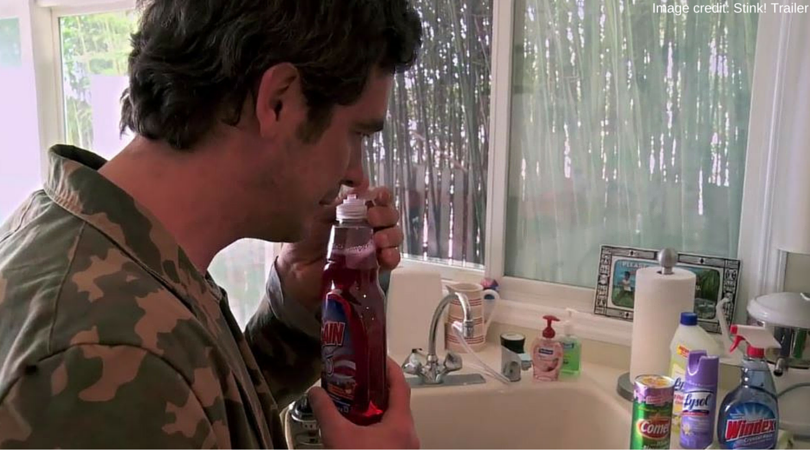What’s that toxic smell? One Father Clashes with the Chemical Industry
The movie Stink! originated with one pair of children’s pajamas that Director John Whelan bought his daughters for Christmas in 2011. The new pajamas, when taken out of their plastic packaging, smelled overwhelmingly of chemicals. That one smell prompted Whelan to look deeper into fragrance and the chemical industry’s use of secret and often toxic chemicals in our everyday products. He simply wanted to know – what’s in the stuff we buy? “It seemed like a common-sense question to ask…I’m just trying to find out what chemicals they would put on kids’ pajamas,” he said. A common-sense question, yes. One with a simple answer? Not so much.
The movie Stink! originated with one pair of children’s pajamas that Director John Whelan bought his daughters for Christmas in 2011. The new pajamas, when taken out of their plastic packaging, smelled overwhelmingly of chemicals.
That one smell prompted Whelan to look deeper into fragrance and the chemical industry’s use of secret and often toxic chemicals in our everyday products. He simply wanted to know – what’s in the stuff we buy? “It seemed like a common-sense question to ask…I’m just trying to find out what chemicals they would put on kids’ pajamas,” he said.
A common-sense question, yes. One with a simple answer? Not so much.

That’s because whether we’re buying pajamas, toys, or lotion, our market is filled with smoke and mirrors. While many companies list ingredients on the back of products, when it comes to personal care products, the term “fragrance” offers a loophole to the chemical industry. Fragrance can be made up of hundreds of different chemicals – including those linked to cancer, neurotoxicity, respiratory problems, and reproductive harm. Because of this loophole in federal law, manufacturers are not required to list these chemicals on labels. This leaves consumers in the dark, with no access to important safety information and, therefore, no way to make an informed decision on which products to buy. Consumers are similarly shut out when it comes to ingredients in other products like furniture, clothing, and electronics, because the Consumer Product Safety Commission (CPSC) does not require ingredient labels, and many things can be declared “propriety”—and therefore remain a secret.
For John Whelan, this fight is personal. His wife died of cancer – and while he doesn’t connect her illness directly to any particular chemicals, he does emphasize that the odds of contracting breast cancer today are far higher than they were forty years ago. That’s in part because there are so many chemicals in our daily lives – from our furniture to our hair products – that the collective effect on our society could be catastrophic.

The amount of chemicals we come into contact with regularly is alarming. The average person is exposed to more than 100 chemicals from personal care products – many of them harmful – before leaving the house each morning. That’s because the agencies meant to protect us from toxic chemicals do not have enough authority, and instead of ensuring our products are safe before they hit the market, chemicals are generally presumed safe until proven otherwise.
Different regulatory entities are supposed to ensure different types of products are safe – but each one has key weaknesses and loopholes. The Food and Drug Administration does not do pre-market safety testing on or approval of personal care products, and similarly, the Consumer Product Safety Commission, which is charged with regulating our furniture, toys, plastic goods, and much more, does not require safety testing on chemical ingredients in many consumer products. The Environmental Protection Agency (EPA) has been nearly powerless to restrict or ban dangerous chemicals, because of our nation’s weak and ineffective law governing toxic chemicals in commerce, the Toxic Substances Control Act (TSCA). (TSCA was just updated by Congress — find out why this update is one step forward, and two steps back here.) Agencies meant to keep us safe are abundant — their effectiveness is a major problem.

While the chemical industry often claims that small amounts of potentially dangerous chemicals do no harm, these small toxic exposures can add up over time. Every day, chemicals in our clothing, household goods, and personal care products make their way into our bodies through our skin and lungs.
John Whelan found chemicals suspected to cause cancer and disrupt hormones in his daughters’ pajamas when he sent them to an independent laboratory, confirming his fears. But this issue reaches far beyond the smelly pajamas that prompted Whelan’s exploration. There’s a reason manufacturers of perfume, furniture, and soap, don’t want us knowing exactly what’s in our products: in many cases, we wouldn’t like the answer. And while many people assume there is some mechanism in place to protect us from dangerous chemicals, it’s clear that the rules and regulations that govern the market leave everyday Americans unprotected.
This single dad’s fight for our right to know what’s in our products is inspiring and enlightening, and this Father’s Day, we commend all fathers fighting for a toxic-free world for their children.
